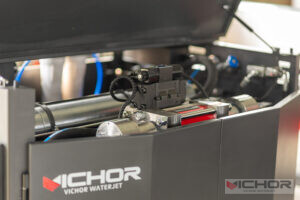5 Must-Know Facts About Waterjet Plasma Cutting Machine for Industrial Efficiency
In the world of industrial manufacturing and metal fabrication, cutting technologies play a pivotal role in determining productivity, precision, and cost-effectiveness. Among these, the waterjet plasma cutting machine stands out as a versatile and powerful tool that combines the benefits of waterjet and plasma cutting methods. This machine is designed to handle a wide range of materials, from metals to composites, offering a unique blend of speed and accuracy. As industries evolve, understanding the intricacies of such equipment becomes essential for optimizing operations. This article delves into five key aspects of the waterjet plasma cutting machine, providing a detailed overview to help you make informed decisions. Whether you’re involved in automotive, aerospace, or general fabrication, grasping these elements can enhance your workflow and investment returns. By the end, you’ll have a clearer picture of how this machine can fit into your manufacturing setup, along with answers to common queries in our FAQ section.
What is a Waterjet Plasma Cutting Machine?
A waterjet plasma cutting machine is an advanced industrial tool that integrates waterjet technology with plasma cutting principles to achieve high-precision cutting across various materials. Essentially, it uses a high-velocity stream of water—often mixed with abrasive substances—to cut through hard materials, while plasma arcs provide additional thermal energy for faster slicing through conductive metals like steel or aluminum. This hybrid approach allows the waterjet plasma cutting machine to deliver clean edges with minimal heat-affected zones, reducing material distortion. Typically, these machines consist of a control system, a high-pressure pump, a cutting head with nozzles, and a plasma torch, all synchronized for efficient operation. The versatility of a waterjet plasma cutting machine makes it suitable for intricate designs and thick materials, bridging the gap between pure waterjet and plasma systems. By understanding its core components, users can appreciate how this machine outperforms traditional methods in terms of adaptability and finish quality.
How Does a Waterjet Plasma Cutting Machine Work?
The operation of a waterjet plasma cutting machine involves a sophisticated process that merges hydraulic force with thermal energy. First, the waterjet component pressurizes water to extremely high levels—often exceeding 60,000 psi—using an intensifier pump. This water is then forced through a small nozzle, creating a focused stream that can cut materials via erosion. When abrasives like garnet are added, the cutting capability extends to harder substances such as titanium or ceramics. Simultaneously, the plasma aspect comes into play for conductive materials: an electric arc ionizes gas (like nitrogen or oxygen) to form plasma, which reaches temperatures high enough to melt metal. In a waterjet plasma cutting machine, these two systems are coordinated through a CNC (Computer Numerical Control) interface, allowing for precise movement and pattern following. This synergy enables the machine to handle diverse tasks, from delicate artistic cuts to heavy-duty industrial slabs, while minimizing kerf width and improving speed. Regular maintenance, such as nozzle checks and abrasive replenishment, ensures consistent performance, making the waterjet plasma cutting machine a reliable choice for dynamic manufacturing environments.
Key Advantages of Using a Waterjet Plasma Cutting Machine
Investing in a waterjet plasma cutting machine offers numerous benefits that cater to modern industrial demands. One major advantage is its versatility; this machine can process a broad spectrum of materials, including metals, plastics, stone, and glass, without the need for tool changes. Unlike laser or pure plasma cutters, the waterjet plasma cutting machine produces no heat distortion on most materials, preserving structural integrity and reducing post-processing efforts. Additionally, it excels in environmental friendliness, as it generates minimal hazardous fumes or waste compared to thermal methods, aligning with sustainability goals. The precision of a waterjet plasma cutting machine is another standout feature, capable of achieving tolerances as tight as ±0.1 mm, which is crucial for industries like aerospace or medical device manufacturing. Cost-effectiveness also plays a role, as the machine’s ability to cut thick materials quickly lowers labor and material costs over time. By leveraging these advantages, businesses can boost efficiency and competitiveness, making the waterjet plasma cutting machine a valuable asset in any fabrication shop.
Common Applications of Waterjet Plasma Cutting Machines
The waterjet plasma cutting machine finds applications across various sectors due to its adaptability and precision. In the automotive industry, it is used for cutting body panels, engine components, and custom parts, ensuring high accuracy and repeatability. Aerospace manufacturers rely on this machine for fabricating turbine blades, structural elements, and composite materials, where tight tolerances are non-negotiable. The construction and architecture fields benefit from its ability to shape stone, tiles, and metals for decorative or functional purposes, such as intricate facades or signage. Moreover, the waterjet plasma cutting machine is popular in art and design for creating detailed sculptures and prototypes, thanks to its ability to handle delicate patterns without compromising material properties. In heavy industries like shipbuilding or oil and gas, it cuts thick steel plates and pipes efficiently, reducing downtime and enhancing safety. By exploring these diverse uses, it’s clear that the waterjet plasma cutting machine is a cornerstone technology driving innovation and productivity in multiple domains.
Factors to Consider When Choosing a Waterjet Plasma Cutting Machine
Selecting the right waterjet plasma cutting machine requires careful evaluation of several factors to match your specific needs. First, consider the machine’s cutting capacity, including maximum thickness and material types it can handle; this ensures it aligns with your project requirements. The power source and energy consumption are critical, as they impact operating costs and efficiency—look for models with high-pressure pumps and optimized plasma systems. Another key aspect is the control system; a user-friendly CNC interface with software compatibility can streamline operations and reduce training time. Maintenance demands should also be assessed, such as the availability of spare parts and ease of cleaning, to avoid prolonged downtime. Lastly, budget constraints play a role; while a waterjet plasma cutting machine might have a higher upfront cost, its long-term savings through reduced waste and increased speed often justify the investment. By weighing these elements, you can choose a machine that enhances your workflow and delivers a strong return on investment, ensuring the waterjet plasma cutting machine becomes a integral part of your operations.
Maintenance demands should also be assessed, such as the availability of spare parts and ease of cleaning, to avoid prolonged downtime. Lastly, budget constraints play a role; while a waterjet plasma cutting machine might have a higher upfront cost, its long-term savings through reduced waste and increased speed often justify the investment. By weighing these elements, you can choose a machine that enhances your workflow and delivers a strong return on investment, ensuring the waterjet plasma cutting machine becomes a integral part of your operations.
Maintenance and Safety Tips for Waterjet Plasma Cutting Machines
Proper maintenance and safety protocols are essential for maximizing the lifespan and performance of a waterjet plasma cutting machine. Regularly inspect and replace worn components like nozzles, seals, and abrasive delivery systems to maintain cutting accuracy and prevent breakdowns. Cleaning the water filtration system and checking for leaks can avoid pressure drops and contamination, which are common issues in daily use. For the plasma part, ensure the torch and electrodes are in good condition to sustain arc stability and cut quality. Safety-wise, operators should wear protective gear, including goggles, gloves, and ear protection, to guard against high-pressure water, UV radiation from plasma arcs, and noise. Implementing emergency stop features and routine training on machine operation reduces accident risks. Adhering to these practices not only prolongs the life of your waterjet plasma cutting machine but also fosters a safer working environment, contributing to overall productivity and compliance with industry standards.
In conclusion, the waterjet plasma cutting machine represents a significant advancement in cutting technology, offering a blend of precision, versatility, and efficiency that meets the demands of various industries. By understanding its definition, operation, advantages, applications, selection criteria, and maintenance, you can leverage this equipment to improve your manufacturing processes. As technology continues to evolve, staying informed about such tools will help you stay ahead in a competitive market. If you’re considering integrating a waterjet plasma cutting machine into your setup, use this guide as a starting point for informed decision-making.
Frequently Asked Questions
Q1: What materials can a waterjet plasma cutting machine effectively cut?
A1: A waterjet plasma cutting machine can cut a wide range of materials, including metals like steel, aluminum, and titanium, as well as non-metals such as plastics, ceramics, glass, and composites. The combination of waterjet and plasma allows it to handle both conductive and non-conductive materials with high precision.
Q2: How does the accuracy of a waterjet plasma cutting machine compare to other cutting methods?
A2: The waterjet plasma cutting machine typically offers high accuracy, with tolerances as tight as ±0.1 mm, which is comparable to or better than many laser and traditional plasma cutters, especially for thick materials. Its ability to minimize heat distortion further enhances precision in delicate applications.
Q3: What are the typical operating costs associated with a waterjet plasma cutting machine?
A3: Operating costs for a waterjet plasma cutting machine include expenses for electricity, water, abrasives, and consumables like nozzles and electrodes. On average, these can range from moderate to high depending on usage, but the machine’s efficiency and reduced waste often lead to long-term savings.
Q4: Can a waterjet plasma cutting machine be used for 3D cutting applications?
A4: Yes, many modern waterjet plasma cutting machines are equipped with multi-axis CNC systems that enable 3D cutting, allowing for complex shapes and bevels. This makes them suitable for advanced fabrication tasks in industries like aerospace and automotive.
Q5: How often should maintenance be performed on a waterjet plasma cutting machine?
A5: Regular maintenance for a waterjet plasma cutting machine should include daily checks for leaks and nozzle wear, weekly cleaning of filters and abrasive systems, and monthly inspections of pumps and plasma components. Following the manufacturer’s guidelines helps ensure optimal performance and longevity.
continue reading
Related Posts
- 1155 words5.8 min read


